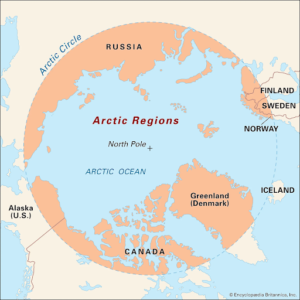In news– The Government of India has released India’s Arctic policy titled “India’s Arctic Policy: Building a Partnership for Sustainable Development” recently.
About the policy-
- India’s Arctic policy lays down six pillars: strengthening India’s scientific research and cooperation, climate and environmental protection, economic and human development, transportation and connectivity, governance and international cooperation, and national capacity building in the Arctic region.
- India’s Arctic policy aims to promote the following agenda—
- Strengthening national capabilities and competencies in science and exploration, climate and environmental protection, maritime and economic cooperation with the Arctic region.
- Inter-ministerial coordination in pursuit of India’s interests in the Arctic.
- Enhancing understanding of the impact of climate change in the Arctic on India’s climate, economic, and energy security.
- Contributing better analysis, prediction, and coordinated policymaking on the implications of ice melting in the Arctic on India’s economic, military and strategic interests related to global shipping routes, energy security, and exploitation of mineral wealth.
- Studying linkages between polar regions and the Himalayas.
- Deepen cooperation between India and countries of the Arctic region under various Arctic forums, drawing expertise from scientific and traditional knowledge.
- Increase India’s participation in the Arctic Council and improve understanding of the complex governance structures in the Arctic, relevant international laws, and geopolitics of the region.
- Implementing India’s Arctic policy will involve multiple stakeholders, including academia, the research community, business, and industry and shall define timelines, prioritize activities and allocate requisite resources.
- The National Center for Polar and Ocean Research (NCPOR) in Goa, an autonomous institute under the Ministry of Earth Sciences, is the nodal institution for India’s Polar research programme, which includes Arctic studies.
- The policy documents the history of India’s relationship with the region, which can be traced back to February 1920, when it signed the Svalbard treaty in Paris.
- In 2007, India launched its first scientific expedition to the Arctic.
- Since then, India has been able to set up an observatory in Kongsfjorden as well as an atmospheric laboratory at Grove Badet.
- Since 2013, India has been an Observer nation in the Arctic Council, where it has consistently participated in meetings of Senior Arctic Officials and contributed to its six Working Groups.
- Under the banner of science and research, the Indian government hopes to build its research capabilities in the region by strengthening existing facilities, such as the Himadri Arctic station in Svalbard.
- It also hopes to align Indian research with international Arctic priorities. The policy further lays down plans to deploy space technology to better study the Arctic region.
The Arctic region-
- The Arctic is the northernmost region of Earth.
- Most scientists define the Arctic as the area within the Arctic Circle, a line of latitude at 66.5° north of the Equator.
- Within this circle are the Arctic ocean basin and the northern parts of Scandinavia, Russia, Canada, Greenland, and the U.S. state of Alaska.
- Apart from being rich in mineral and oil resources, the Arctic region is also particularly significant due to the many shipping routes that run through it.

Arctic Council-
- It is a high-level intergovernmental forum to promote cooperation, coordination, and interaction towards sustainable development and environmental protection in the Arctic.
- It was formally established in 1996.
- All Arctic Council decisions and statements require consensus of the eight Arctic States.
- Only states with territory in the Arctic can be members of the council.
- The member states consist of Canada, Denmark(representing Greenland), Finland, Iceland, Norway, Russia, Sweden and the United States.
- The Ottawa Declaration defines these states as Members of the Arctic Council.
- The Council’s Strategic Plan 2021-2030 guides its work towards the Arctic as a “region of peace, stability and constructive cooperation, that is a vibrant, prosperous, sustainable and secure home for all its inhabitants, including Indigenous Peoples, and where their rights and wellbeing are respected.”
Further reading: https://journalsofindia.com/indias-arctic-policy/














